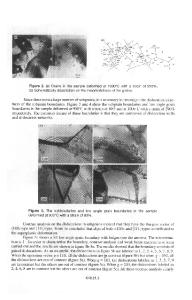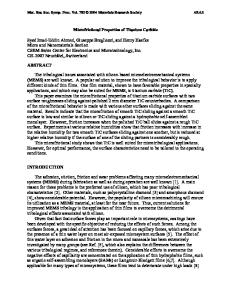Processing and superplastic properties of fine-grained iron carbide
- PDF / 1,680,822 Bytes
- 9 Pages / 630 x 792 pts Page_size
- 54 Downloads / 289 Views
I.
INTRODUCTION
IT has been shown that a fine-grained-extruded iron carbide material prepared from rapidly solidified powders exhibits superplastic properties over a wide range of strain rates and temperatures, t~l The material consisted of 80 vol pct iron carbide (Fe3C) and 20 vol pct of an iron-base second phase. It was shown that tensile elongation as high as 600 pct could be achieved. The tensile ductility in the high strain-rate-sensitivity region, however, was shown to be a strong function of temperature (T) and strain rate (6) and to increase as the product exp (Qc/RT) decreased, where Qc is the activation energy for plastic flow. These results indicate that high m values are a necessary but not sufficient condition for observing large tensile ductility in the Fe-5.25 pct C-1.5 pct Cr material, as is the case for many other ceramicbased materials. Since deformation behavior is very sensitive to the microstructure, an attempt is made in the present investigation to establish the influence of processing history and grain size on the high-temperature mechanical behavior of the iron carbide material. With this objective in mind, hot isostatically pressed (hipped), hipped-and-pressed, and extruded-and-pressed materials
WOO-JIN KIM, Graduate Student, and OLEG D. SHERBY, Professor, are with the Department of Materials Science and Engineering, Stanford University, Stanford, CA 94305. JEFF WOLFENSTINE, Assistant Professor, is with the Department of Mechanical and Aerospace Engineering, University of California, Irvine, CA 92717. OSCAR A. RUANO, Senior Research Scientist, is with the Centro Nacional de Investigaciones Metahirgicas, C.S.I.C., Av. de Gregorio del Amo 8, 28040 Madrid, Spain. GEORG FROMMEYER, Professor, is with the Max Planck Institut for Eisenforschung GMBH, Max Planck Strasse 1, 4000 Diisseldorf 1, Federal Republic of Germany. Manuscript submitted May 23, 1991. METALLURGICAL TRANSACTIONS A
were prepared and their stress-strain rate relations and ductility characteristics were investigated at elevated temperature.
II. MATERIALS, PROCESSING, AND EXPERIMENTAL TECHNIQUES The material chosen has the following composition: 5.25 pct C, 1.5 pct Cr, and balance Fe (by weight). Powders of this material were produced by argon gas atomization. The surface of a typical as-received powder is shown in Figure 1. The powder reveals a dendritic structure consisting of proeutectic carbides in the form of channels and ledeburite filling in the isolated pockets (ledeburite is a mixture of carbide and retained austenite). The volume fraction of proeutectic carbide based upon the iron-carbon phase diagram is about 40 pct by volume. In order to obtain bulk material, the powders were first sieved to less than 50/.~m and were then compacted using three different processing procedures. These procedures are schematically illustrated in Figure 2. The first method involved hot isostatic pressing (HIP). The powders were placed in a mild steel round can, degassed, and then isostatically pressed at 180 MPa for 3 hours at 700 ~ Thi
Data Loading...






